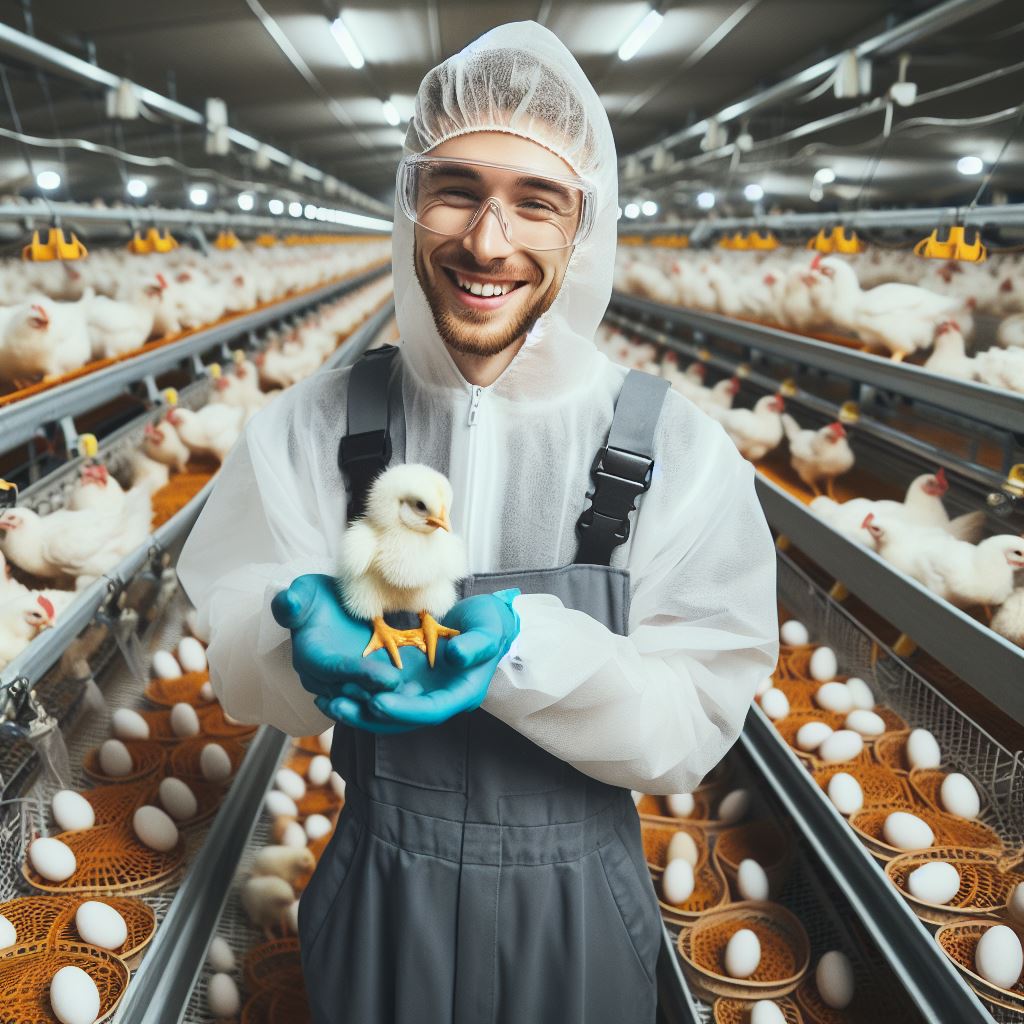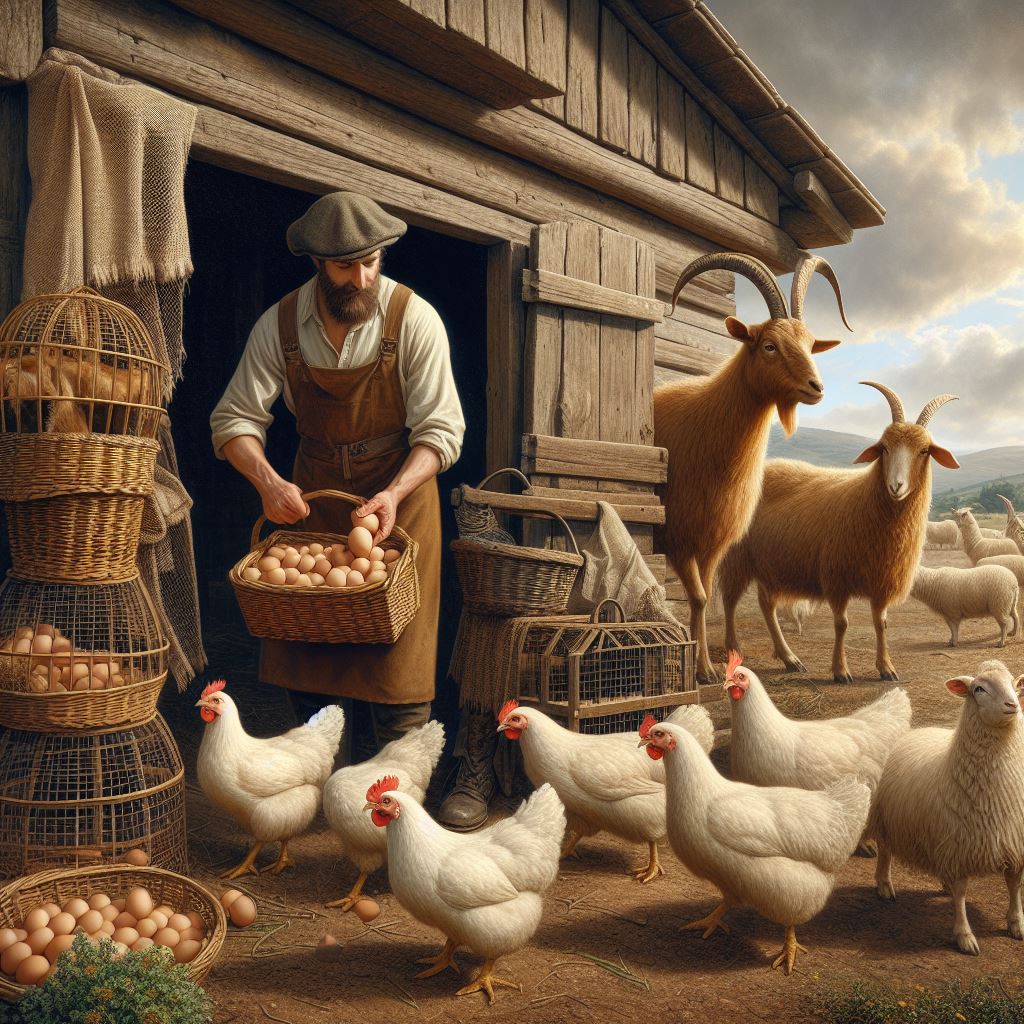Introduction
Maximizing profit is crucial for success in small-scale poultry farming as it ensures financial sustainability.
Importance of maximizing profit in small-scale poultry farming
Maximizing profit in small-scale poultry farming is crucial for sustainable growth.
It ensures financial stability, allowing for necessary investments in quality feed, equipment, and healthcare.
Profitability fosters the expansion of the flock, enhances overall productivity, and enables the farmer to adapt to market dynamics.
Ultimately, a well-managed profit margin in poultry farming is vital for long-term success, livelihood improvement, and the provision of quality products to consumers.
The focus of the blog post
This blog post will provide useful insights on strategies to maximize profit in small-scale poultry farming.
Overview of small-scale poultry farming
Definition and scope
Small-scale poultry farming refers to the practice of raising poultry on a small scale.
It typically involves keeping a limited number of birds, such as chickens, ducks, or turkeys.
The scale of operation can vary depending on the resources and preferences of the farmer.
Small-scale poultry farming can be conducted in backyards, small plots of land, or even in urban areas.
It is a popular form of agricultural activity for both subsistence and commercial purposes.
Advantages and challenges
Small-scale poultry farming offers several advantages for farmers and communities.
Firstly, it provides a source of fresh and nutritious protein-rich food.
Small-scale operations require low initial investments and can be managed with limited infrastructure.
It allows farmers to diversify their agricultural activities and generate additional income.
Transform Your Agribusiness
Unlock your farm's potential with expert advice tailored to your needs. Get actionable steps that drive real results.
Get StartedPoultry production is relatively quick, with shorter harvesting cycles compared to other livestock.
However, small-scale poultry farming also brings its own set of challenges.
Disease outbreaks can occur easily in crowded or improperly managed poultry houses.
Proper care, management, and biosecurity measures are essential to prevent losses.
Marketing and distribution can be challenging when operating on a small scale.
Finding a reliable market for poultry products may require additional efforts and networking.
Importance of profit maximization in this context
Profit maximization is crucial for the success and sustainability of small-scale poultry farming.
Maximizing profit ensures the viability of the operation and the farmer’s livelihood.
Increased profitability allows for reinvestment in infrastructure, equipment, and improved management practices.
Efficient production practices and cost management are key to achieving profit maximization.
Farmers need to carefully analyze their costs, including feed, labor, housing, and veterinary expenses.
Implementing improved feeding techniques and disease prevention strategies can help reduce costs.
Exploring value-added products, such as processed poultry, can also contribute to higher profit margins.
Small-scale poultry farmers should continuously evaluate market trends and adapt their production accordingly.
They might consider organic, free-range, or specialty poultry products to target niche markets and increase profits.
Regular market research and customer feedback are vital for understanding consumer preferences and demands.
In general, small-scale poultry farming has its advantages and challenges.
Profit maximization is essential for the success of these enterprises.
While challenges like disease outbreaks and marketing hurdles exist, careful management, cost control, and market analysis can help maximize profits in small-scale poultry farming.
Read: Poultry Genetics: Raising Superior Chickens
Understanding the Market
In this section, we will delve into the importance of understanding the market when it comes to maximizing profit in small-scale poultry farming.
Researching Demand and Target Market
Researching the demand for poultry products is crucial to determine potential profitability.
Market research should involve identifying potential customers, their preferences, and buying patterns.
Through careful analysis, farmers can identify the target market for their poultry products, whether it’s local consumers, restaurants, or grocery stores.
Showcase Your Farming Business
Publish your professional farming services profile on our blog for a one-time fee of $200 and reach a dedicated audience of farmers and agribusiness owners.
Publish Your ProfileUnderstanding the demand and target market allows farmers to tailor their production and marketing strategies to meet specific consumer needs, increasing the likelihood of maximizing profit.
Identifying Niche Opportunities
In addition to researching the overall market, it is essential to identify niche opportunities within the poultry industry.
A niche market refers to a specialized segment that is not adequately served by mainstream suppliers, creating an opportunity for small-scale farmers.
These niche markets can include organic or free-range poultry, specialty breeds, or specific products such as eggs or processed poultry products.
By identifying and targeting niche opportunities, farmers can differentiate themselves from larger competitors and potentially command higher prices, resulting in increased profitability.
Building Relationships with Buyers
Building strong relationships with buyers is a critical aspect of maximizing profit in small-scale poultry farming.
Establishing connections with local restaurants, grocery stores, or even individual customers can lead to consistent and reliable sales.
Creating a personal relationship with buyers allows farmers to understand their needs, preferences, and quantity requirements.
By catering to specific buyer demands, farmers can cultivate a loyal customer base, ensuring a consistent market for their poultry products.
Additionally, these relationships can provide valuable feedback on product quality, pricing, and potential new market opportunities.
Regular communication and a customer-centric approach are vital to sustaining and growing these relationships over time.
To summarize, maximizing profit in small-scale poultry farming requires a comprehensive understanding of the market.
This involves researching the demand and target market, identifying niche opportunities, and building strong relationships with buyers.
By conducting thorough market research, farmers can tailor their production and marketing strategies to meet specific consumer needs.
Identifying niche opportunities allows for differentiation and potentially higher prices, while building relationships with buyers ensures consistent sales and valuable feedback.
By actively engaging with the market, small-scale poultry farmers can achieve greater profitability and success.
Read: The Importance of Biosecurity in Poultry Farms
Efficient flock management
Selecting the right breed for profitability
- Research and identify poultry breeds that have a high potential for profit.
- Consider factors such as growth rate, feed conversion, and market demand.
- Look for breeds that are known for their disease resistance and high egg production.
- Consult experts or experienced farmers to get advice on the most profitable breeds.
- Take into account the local climate and environment to ensure the breed is suitable.
Proper housing and ventilation
- Provide adequate housing facilities for your poultry to ensure their health and productivity.
- Design the housing structure to allow for proper ventilation, minimizing the risk of respiratory diseases.
- Ensure the housing is protected from predators and provides enough space for the flock to move comfortably.
- Regularly clean and disinfect the housing to maintain hygienic conditions and prevent the spread of diseases.
- Monitor the temperature and humidity levels inside the housing and make necessary adjustments to create a favorable environment for the flock.
Feeding and nutrition
- Develop a well-balanced diet for your poultry that meets their nutritional requirements.
- Use high-quality feed ingredients to ensure maximum nutrient absorption and growth.
- Consult a poultry nutritionist to formulate an optimized feed ration based on the breed and production goals.
- Provide fresh and clean water at all times, as dehydration can negatively impact flock performance.
- Monitor the feed intake and adjust the feeding program accordingly to avoid over or underfeeding.
Health management and disease prevention
- Implement a comprehensive health management plan to prevent the spread of diseases.
- Vaccinate your flock against common poultry diseases based on the recommended schedule.
- Regularly inspect the flock for signs of illness and promptly isolate any sick birds.
- Maintain strict biosecurity measures to minimize the risk of introducing pathogens to your flock.
- Consult with a veterinarian for regular check-ups and seek professional advice in case of emergencies.
Minimizing losses and waste
- Implement efficient waste management practices to minimize losses and maintain a clean environment.
- Properly dispose of mortalities to prevent the spread of diseases and attract predators.
- Regularly clean feeders and waterers to prevent contamination and ensure efficient feed utilization.
- Monitor and manage feed wastage by avoiding overfilling the feeders and using feeders that reduce spillage.
- Keep track of production and financial records to identify areas of improvement and optimize profitability.
In essence, efficient flock management is crucial for maximizing profit in small-scale poultry farming.
By selecting the right breed, providing proper housing and ventilation, ensuring balanced nutrition, managing health effectively, and minimizing losses and waste, poultry farmers can optimize their operations and achieve profitability.
Regular monitoring, consulting experts, and continuously improving practices are essential for long-term success in the poultry industry.
Read: Poultry Behavior: Understanding Your Flock

Streamlining production processes
In order to maximize profit in small-scale poultry, it is essential to streamline production processes.
This involves implementing automation and technology, optimizing feed conversion efficiency, improving operational workflows, and reducing energy and resource consumption.
Implementing automation and technology
- Investing in automated feeding systems can improve efficiency and reduce labor costs.
- Using sensors and monitoring devices can provide real-time data on poultry health and performance.
- Implementing automated egg collection systems can save time and minimize egg breakages.
- Utilizing technology for temperature and humidity control can ensure optimal conditions for poultry.
- Adopting automated cleaning systems can maintain a clean and hygienic environment for the poultry.
Optimizing feed conversion efficiency
- Using high-quality feed ingredients can improve nutritional value and boost feed conversion efficiency.
- Balancing the ratio of proteins, carbohydrates, and fats in the feed can enhance poultry growth.
- Implementing controlled feeding programs can prevent over-consumption and reduce feed wastage.
- Regularly monitoring feed consumption and adjusting feed formulations accordingly can optimize efficiency.
- Providing a consistent feeding schedule can improve digestion and minimize stress in the poultry.
Improving operational workflows
- Implementing standardized operating procedures can minimize errors and increase productivity.
- Using efficient record-keeping systems can track performance and identify areas for improvement.
- Training and educating staff on best practices can enhance their skills and reduce mistakes.
- Establishing clear communication channels between different teams can streamline collaboration.
- Regularly reviewing and analyzing production data can identify bottlenecks and implement corrective measures.
Reducing energy and resource consumption
- Installing energy-efficient lighting systems can reduce electricity costs.
- Using insulation and ventilation systems can optimize temperature control and reduce energy waste.
- Implementing water-saving techniques, such as drip irrigation, can conserve resources.
- Recycling and reusing waste materials can minimize environmental impact and save costs.
- Exploring renewable energy sources, such as solar panels, can reduce dependence on traditional energy.
By implementing these strategies and continuously evaluating and improving production processes, small-scale poultry producers can maximize their profit while maintaining sustainable and efficient operations.
Read: Sustainable Poultry Farming Practices
Maximizing farm revenue
A profitable and successful small-scale poultry farm requires strategic planning and implementation of various techniques to maximize revenue.
By diversifying products, creating value-added products, using direct marketing, and collaborating with local businesses, farmers can boost their profits.
Diversifying products (e.g., eggs, meat, feathers)
Instead of solely focusing on a single product, such as eggs or meat, poultry farmers can expand their offerings to include other products like feathers.
In this way, they tap into different markets and cater to diverse customer preferences.
Offering a variety of products not only increases revenue potential but also provides a buffer in case of market fluctuations.
Value-added products and packaging
To maximize profits, poultry farmers can enhance the value of their products by processing them into value-added items.
For example, they can create ready-to-cook marinated chicken cutlets or develop unique egg-based recipes.
Additionally, attractive and professional packaging can significantly increase the perceived value of the products and attract more customers willing to pay a premium.
Direct marketing and sales channels
By cutting out intermediaries, farmers can increase their profitability by selling directly to consumers.
This approach allows them to capture the full value of their products and establish personalized relationships with customers.
Setting up roadside stands, participating in farmers markets, and utilizing online platforms can broaden the reach and enable direct sales.
Engaging customers through social media and newsletters can also create loyalty and accelerate repeat purchases.
Collaboration with local businesses and restaurants
Forming partnerships with local businesses, such as grocery stores, restaurants, and catering companies, can open up additional revenue streams for poultry farmers.
Supplying these establishments with fresh, high-quality poultry products can lead to consistent sales and long-term contracts.
Showcase Your Farming Business
Publish your professional farming services profile on our blog for a one-time fee of $200 and reach a dedicated audience of farmers and agribusiness owners.
Publish Your ProfileCollaboration can also include joint marketing efforts and menu promotions to increase brand visibility and attract more customers.
In summary, optimizing revenue in small-scale poultry farming demands diversification, value addition, direct marketing, and collaboration.
By expanding product offerings, creating value-added products, selling directly, and partnering with local businesses, farmers can secure a competitive edge in the market and maximize their profits.
Implementing these strategies effectively and consistently can result in steady revenue growth and a sustainable poultry business.
Cost management and optimization
Efficient use of resources (feed, water, energy)
- Implement proper feeding techniques to minimize feed wastage and maximize poultry growth.
- Install automated water systems to ensure efficient water distribution and reduce wastage.
- Optimize energy usage by investing in energy-efficient equipment and implementing energy-saving practices.
Sourcing affordable supplies
- Research and identify local suppliers offering quality poultry feed at competitive prices.
- Consider establishing partnerships with other poultry farmers to bulk purchase supplies at discounted rates.
- Explore alternative feed sources such as agricultural by-products to reduce feed costs.
Budgeting and financial planning
- Create a detailed budget outlining all expenses and projected revenue for better financial management.
- Regularly review and update the budget to reflect any changes in costs or market conditions.
- Seek professional advice from accountants or financial advisors to ensure effective planning.
Reducing unnecessary expenses
- Regularly monitor and track expenses to identify areas where costs can be reduced.
- Optimize operational processes to minimize labor costs and increase productivity.
- Eliminate non-essential expenditures that do not contribute significantly to poultry profitability.
Implementing cost management strategies is crucial for maximizing profit in small-scale poultry farming.
By efficiently utilizing resources, sourcing affordable supplies, carefully budgeting, and reducing unnecessary expenses, farmers can boost their bottom line and achieve financial success in the poultry industry.
Analyzing data and tracking performance
A successful small-scale poultry business requires constant analysis of financial and production data to ensure maximum profitability.
By utilizing data effectively, you can identify areas for improvement and adjust strategies based on data insights.
Utilizing financial and production data
- Gather and organize financial data such as sales, expenses, and investments.
- Analyze the financial data to determine the overall profitability of the poultry business.
- Track production data including feed consumption, growth rates, and mortality rates.
- Compare production data with financial data to identify any discrepancies or issues.
- Use software or spreadsheets to effectively manage and analyze the collected data.
Measuring key performance indicators
- Identify key performance indicators (KPIs) that are relevant to the poultry business.
- Examples of KPIs include feed conversion ratio, average daily gain, and revenue per bird.
- Regularly measure and monitor these KPIs to assess the performance of the poultry business.
- Compare the KPIs with industry benchmarks to determine areas that need improvement.
- Set realistic targets for each KPI and track progress towards achieving those targets.
Identifying areas for improvement
- Analyze the collected data to identify areas where the poultry business can improve.
- Look for inefficiencies in feed utilization, high mortality rates, or low revenue per bird.
- Identify any bottlenecks or constraints that are limiting production and profitability.
- Consider external factors such as market conditions or regulatory changes that may affect the business.
- Develop strategies to address the identified areas for improvement and maximize profitability.
Adjusting strategies based on data insights
- Regularly review and analyze the data insights to make informed decisions.
- Consider adjusting feeding programs, vaccination protocols, or production schedules based on data trends.
- Monitor the impact of the adjustments and track the performance of the poultry business.
- Continuously update and refine the strategies based on ongoing data analysis.
- Stay proactive in adapting to market changes and evolving consumer demands to optimize profitability.
By actively analyzing data, measuring key performance indicators, identifying areas for improvement, and adjusting strategies based on data insights, small-scale poultry businesses can achieve maximum profitability.
The continuous tracking of performance ensures the efficient management of resources and allows for informed decision-making.
Importance of continuous learning and adaptation
Staying updated with industry trends
- Regularly reading industry publications and websites to stay informed.
- Following social media accounts of poultry experts and organizations for updates.
- Attending conferences and seminars to gain insights into the latest market trends.
Participating in workshops and training programs
- Joining workshops on poultry management to enhance skills and knowledge.
- Attending training programs to learn about new technologies and best practices.
- Engaging with experts and experienced farmers to gain practical tips and advice.
Networking with other poultry farmers
- Joining local or regional poultry associations to connect with fellow farmers.
- Participating in industry events to meet and learn from successful poultry entrepreneurs.
- Building relationships with suppliers and buyers to stay informed about market demands.
Experimenting with new techniques and ideas
- Trying out innovative approaches such as alternative feed sources or biosecurity methods.
- Implementing trial runs to assess the effectiveness and profitability of new techniques.
- Seeking feedback from customers and industry professionals to improve operations.
Conclusion
Key points discussed in the blog post
In this blog post, we discussed the key points for maximizing profit in small-scale poultry farming.
The significance of profit maximization in small-scale poultry farming
Profit maximization is significant in small-scale poultry farming as it ensures a sustainable and profitable business.
. It ensures efficient resource allocation, covering operational costs, and generating income.
Maximizing profits allows farmers to invest in better equipment, quality feed, and healthcare for poultry.
Additionally, it fosters economic resilience, enabling farmers to withstand unforeseen challenges.
Ultimately, profitable poultry farming contributes to the livelihood of farmers and the overall development of the local agricultural sector.
Encouragement for readers to implement the strategies and tips provided
We encourage readers to implement the strategies and tips provided to improve their profitability in poultry farming.
Unlock your potential by applying these proven strategies.
Embrace change, stay consistent, and watch your growth unfold.
Small steps lead to big transformations.
Your success journey begins with action




